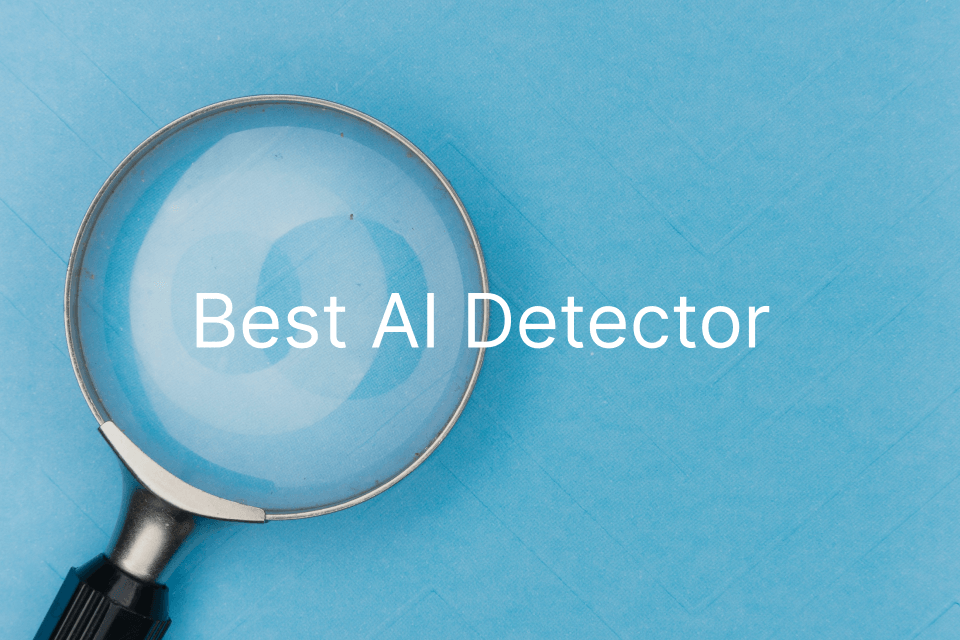Best AI Detector in 2025

TABLE OF CONTENTS
Key Points
- Growing Necessity: In 2025, robust AI content detection is crucial as AI models like ChatGPT, GPT-4, and Google Gemini become ubiquitous.
- Leading Tools: ZeroGPT, QuillBot AI Content Detector, Grammarly AI Detector, and OpenL AI Detector are among the most prominent tools for identifying AI-generated content.
- Accuracy Varies: While some tools claim high accuracy, independent tests show varying results, with even leading detectors capable of false positives or negatives.
- Free vs. Premium: Free tools like OpenL and QuillBot offer accessible options, but premium services often provide higher accuracy, more features, and greater capacity.
- Controversial Nature: AI detection results can be highly debated, especially in academic and professional settings, due to potential inaccuracies and biases. Combining these tools with other verification methods (e.g., assessing writing style, checking drafts) is strongly advised.
Introduction
As AI-generated text from models like ChatGPT, GPT-4, and Google Gemini becomes increasingly sophisticated and widespread, the ability to distinguish it from human writing is more critical than ever in 2025. This review compares four leading AI content detection tools—ZeroGPT, QuillBot AI Content Detector, Grammarly AI Detector, and OpenL AI Detector—examining their features, advantages, disadvantages, and unique selling propositions. We will particularly highlight OpenL’s offering as a compelling free solution.
Featured AI Content Detection Tools
ZeroGPT
- Overview: ZeroGPT is a widely used tool for detecting AI-generated content from various models, including GPT-4, ChatGPT, and Gemini. It is often cited as a free and user-friendly option.
- Key Features:
- Sentence-level AI detection with highlighted AI text.
- Supports all languages using DeepAnalyse™ Technology.
- Offers batch file processing, API access, and auto-generated PDF reports (premium features).
- Includes additional tools such as a plagiarism checker, paraphraser, and summarizer.
- Free Tier Details: Allows scanning up to 15,000 characters per AI detection for free, with no daily limits or sign-up required.
- Unique Aspects: Provides detailed sentence and document-level analysis, making it suitable for organizations and individuals needing comprehensive reports.
QuillBot AI Content Detector
- Overview: QuillBot’s free detector is designed to identify both AI-generated and AI-refined content from tools like ChatGPT, GPT-4, and Claude. It’s part of a broader suite of writing tools.
- Key Features:
- Multilingual support with fast, detailed reports and downloadable PDFs.
- Analyzes linguistic patterns like perplexity and burstiness to minimize false positives.
- Offers line-by-line feedback for easier editing and re-scanning.
- Free Tier Details: Free to use with a limit of up to 1,200 words per scan.
- Unique Aspects: Distinguishes between purely AI-generated and AI-refined text, which can help reduce bias against non-native English writers or those using basic AI assistance for refinement.
Grammarly AI Detector
- Overview: Integrated into Grammarly’s premium suite, this detector supports responsible AI use for its Premium, Business, and Education subscribers.
- Key Features:
- Provides percentage-based AI detection.
- Features an “Authorship” tool to categorize text sources.
- Seamlessly integrates with Grammarly’s plagiarism checks, citation generation, and extensive writing assistance features.
- Offers shareable reports and a replay feature for transparency.
- Availability: Requires a Premium, Business, or Education subscription to Grammarly.
- Unique Aspects: Emphasizes transparency and comprehensive writing support, making it ideal for academic and professional environments where integrity and clear communication are paramount. Its detection can sometimes be more conservative, leading to a higher rate of missed AI content in some tests.
OpenL AI Detector
- Overview: OpenL’s Free AI Content Detector is a straightforward, no-login-required tool for quickly assessing AI-generated text from models like ChatGPT, GPT-4, and Gemini.
- Key Features:
- Analyzes up to 5,000 characters per scan.
- Provides real-time analysis with a percentage breakdown of AI-generated vs. human-written content.
- No login is required for basic free use.
- Integrated with OpenL’s broader suite of translation services.
- Free Tier Details: Offers a daily limit of 30 uses for the AI Detector.
- Unique Aspects: Its complete freeness and extreme ease of use make it perfect for quick, casual checks without any financial commitment or account setup. It’s particularly appealing for users already leveraging OpenL’s translation capabilities.
Pros and Cons Comparison
| Tool | Pros | Cons |
|---|---|---|
| ZeroGPT | High accuracy (claimed >98%), multilingual support, batch processing (premium), API access (premium), detailed reports. Free tier is generous (15,000 characters per scan, no daily limits). | Free tier has character limit per scan; advanced features like batch processing and detailed reports require subscription. Independent tests show varying accuracy with ChatGPT-generated text, and potential for false positives (around 9.6% in some tests). |
| QuillBot | Free to use (up to 1,200 words per scan), distinguishes between AI-generated and AI-refined content, multilingual, fast reports, line-by-line feedback. Often shows high accuracy in recent tests (some reporting 100%). | Limited word count for free scans (1,200 words). Accuracy can be inconsistent between different tests or even for the same text over time. |
| Grammarly | Comprehensive writing suite integration, emphasis on transparency, citation support, useful for academic/professional settings. | Requires a paid Premium, Business, or Education subscription. May miss a significant percentage of AI content (some tests show ~65% missed). Potential for bias against non-native English writing styles. |
| OpenL | Completely free for its basic daily uses, no login required for quick checks, extremely user-friendly, integrated with translation services. | Has a daily limit of 30 uses for the free AI detector. Provides basic analysis without sentence-level highlights. Lacks publicly disclosed accuracy metrics, making its reliability for critical tasks less certain. Limited to 5,000 characters per scan. |
Detailed Comparison
-
Accuracy
- ZeroGPT: Claims high accuracy (>98% on their site). Independent tests in 2025 show mixed results, performing well in some scenarios but sometimes struggling with specific AI models or having a higher false positive rate (e.g., ~9.6% false positives for human text in one study).
- QuillBot: Recent independent tests (February 2025) have shown QuillBot achieving perfect 100% accuracy in some controlled scenarios, though historical data points to inconsistency. Best for initial checks, but results should be verified.
- Grammarly: While reliable within its integrated writing suite, independent tests indicate Grammarly’s AI detector can miss a significant portion of AI-generated content (e.g., failing to detect ~65% of AI text in one study). Not 100% accurate, but aims for responsible AI use.
- OpenL: Described as “quick and accurate” by its developers, but specific, independently verified accuracy metrics are not publicly available. Best suited for preliminary checks where high stakes are not involved.
-
Ease of Use
- ZeroGPT: Generally user-friendly for basic text input. Advanced features like batch processing or API access might require a slight learning curve.
- QuillBot: Features a simple, intuitive interface, with line-by-line feedback that assists in editing.
- Grammarly: Seamlessly integrated within Grammarly’s well-known platform, requiring familiarity with the broader suite.
- OpenL: Exceptionally easy to use; simply paste text, and no account is needed, making it ideal for quick, on-demand checks.
-
Pricing
- ZeroGPT: Offers a robust free tier (15,000 characters per scan) and paid plans for extended features, higher character limits, and more batch processing.
- QuillBot: The AI detector is fully free, though other QuillBot tools may have premium features.
- Grammarly: The AI detector is exclusively available as part of its paid Premium, Business, or Education subscriptions.
- OpenL: Free with a daily limit of 30 uses and a 5,000-character limit per scan; paid upgrade options are available primarily for their translation services, which share the credit system.
-
Additional Features
- ZeroGPT: Includes a plagiarism checker, paraphraser, summarizer, and offers social media integrations (e.g., WhatsApp, Telegram) for premium users.
- QuillBot: Part of a comprehensive suite that includes a paraphraser, grammar checker, summarizer, and citation generator.
- Grammarly: A full-fledged writing assistant offering plagiarism detection, citation generation, advanced grammar, style, and clarity suggestions.
- OpenL: Primarily focused on translation, with the AI detector serving as a convenient add-on.
-
Target Audience
- ZeroGPT: Educators, publishers, content creators, and organizations requiring scalable and detailed AI detection solutions.
- QuillBot: Students, writers, and professionals looking for free and comprehensive writing enhancement tools that include AI detection.
- Grammarly: Students, professionals, businesses, and educators who value transparency, holistic writing support, and are already invested in the Grammarly ecosystem.
- OpenL: Educators, publishers, content managers, and users of translation services who need quick, free, and straightforward AI content verification.
Highlighting OpenL AI Detector
OpenL’s Free AI Content Detector shines due to its accessibility and sheer simplicity, positioning it as an excellent choice for users requiring quick, cost-free authenticity checks:
- Cost-Effective: Completely free for up to 30 daily uses, with no login or financial commitment required.
- Simplicity: Users can paste text and receive instant results, making it highly intuitive and requiring no technical expertise.
- Daily Limit: The 30-use daily limit and 5,000-character per scan limit are often sufficient for most casual or frequent small-scale checks.
- Integration: As part of OpenL’s broader and trusted translation platform, it adds value for multilingual users or those already using their translation services.
- No Commitment: The ability to use the tool without creating an account significantly enhances user convenience and privacy.
Conclusion
In 2025, ZeroGPT, QuillBot, Grammarly, and OpenL stand out as key players in the AI content detection landscape, each addressing distinct user needs. ZeroGPT and Grammarly offer more robust, feature-rich options often suited for professional or academic rigor (though with varying accuracy in independent tests), while QuillBot and OpenL provide highly accessible free solutions.
OpenL’s Free AI Content Detector, available at OpenL AI Detector, is particularly compelling for its ease of use, cost-effectiveness, and no-commitment access, making it an ideal choice for educators, publishers, and content managers seeking rapid authenticity verification. While AI detectors are valuable screening tools, remember that no tool is 100% infallible, and combining detection with human review remains the best practice for ensuring content integrity. Visit OpenL today to quickly assess your content’s authenticity.


